Building owners and managers, residents, and other end-users benefit from learning about a new sprinkler system
Retrofitting an existing building with fire sprinklers is a smart choice that protects lives and property while possibly achieving construction allowances and insurance discounts. And it’s the law, in many cases.
The “model codes” that form the basis of laws have upped the sprinkler requirements for certain occupancies in recent years, including existing high-rises and assembly occupancies. And various states and cities, such as New York City, Florida, San Antonio, Texas, Connecticut, Virginia, New Jersey, and others have enacted various retrofit mandates for specific building types.
Beyond current law, the trend is clear: fire sprinklers save lives—and advocacy groups and lawmakers are pressing for additional mandates in many areas.
Fire sprinkler retrofits are an amazing opportunity to increase public safety. But they also present challenges for some end-users, including knowing when a retrofit is necessary, the logistics of completing one, and developing the knowledge to understand the project and maintain the sprinkler system.
We’ve covered those first two issues (and more) in previous installments of this series:
- Why and When the US Retrofits Sprinklers in Existing Buildings
- Retrofitting Fire Sprinklers: What a Large-Scale Project Needs for Success
Now, we’re going to look at how property owners, managers, and even occupants can get a good understanding of a system as it’s installed and afterward.
Fire sprinkler installation and maintenance rules can be daunting to everyone but the fire sprinkler contractor and design team. But the end-user should still have some knowledge of the equipment that protects them and their property. Let’s dive into some basics.
If you need parts for a sprinkler retrofit or system maintenance, check out our selection of commercial sprinklers, residential sprinklers, system components, and installation tools.
The standards for sprinklers
Model, local, and state codes outline the rules for when a sprinkler system is required, among many other things. A standard provides the rules for installing and maintaining a fire protection system. Essentially, a code tells “when” something is needed, whereas a standard describes the “how.”
The standard for commercial fire sprinkler installations is NFPA 13: Standard for Installation of Sprinkler Systems. There is also NFPA 13R, which covers low-rise residential structures, and NFPA 13D, which is the home installation standard.
These documents contain the detailed rules for fire sprinkler heads, piping, valves, pipe hangers, spacing, water supply, calculation methods, and a lot more. Code officials—typically fire marshals and inspectors—enforce these rules, which gain the force of law when a model code is adopted as a local or state code.
Engineers and layout technicians design the system using these rules. Fire sprinkler contractors and fitters build it using them.
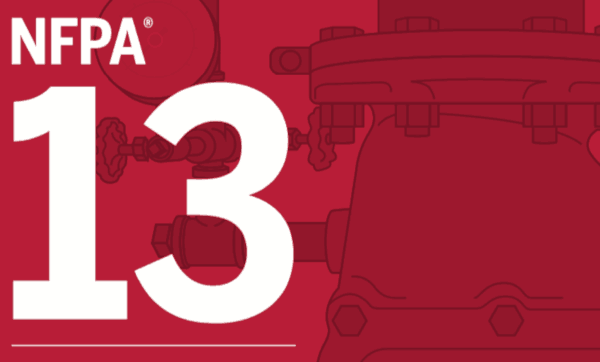
It starts with the book
NFPA 13 is published by the National Fire Protection Association (NFPA), the leading worldwide authority on fire protection. And it is found in nearly every library, city clerk’s office, building department, and fire department for free public viewing and use.
NFPA also provides a free version to view on its website; simply register for an account and log into your new profile, and a viewable PDF becomes an option.
NFPA 13 is the oldest installation standard in the US. It was first published in 1896 and has been updated nearly every three years since. The latest edition as of this writing is 2022, but note that many code officials in the country are still using the 2019 or 2016 editions (and maybe even earlier), as there is always a lag in new model codes and standards being adopted as laws.
You can discover which version is being employed in your area by doing an online search, or simply asking your local fire marshal, system designer, or sprinkler contractor. It’s important to know which edition because, as we’ll cover below, the standard experienced a significant reorganization in 2019.
Who makes these fire sprinkler rules, anyway?
In the first few pages of NFPA 13, there is a summary of the whole 120+ years of the standard, a Table of Contents, and several pages of names.
The latter list shows the members of the technical committees that write the rules in NFPA 13. While the text of the standard may seem dry and complex, remember that each person on the committee is, indeed, a real person!
They are all subject-matter experts in the fire sprinkler field, and each (or, at least, many) can be contacted for more information or questions. Some of them are fire protection equipment manufacturers, others are contractors, and some are code officials. But every member of the NFPA 13 committee is selected and trusted to make the right decision for the minimum—yes, minimum—rules for installing a safe and effective fire sprinkler system.
I have a copy of NFPA 13 and it’s open—now what?
An end-user, such as a condo owner or building manager, is not an expert on fire sprinkler systems—and they are not expected to be! However, it can pay to get to know a system and the rules governing it during and after a fire sprinkler retrofit.
This basic knowledge will help you assess the need (and proposals) for certain design choices and equipment, as well as maintenance down the road. When your contractor calls and tells you that the system needs a hydrostatic test five years from installation, for example, you’ll either know what that is or can find it quickly—and understand why it’s necessary.
And fundamentally, speaking the same language as the designers, installers, and contractors can be a big help, even if it’s not strictly necessary.
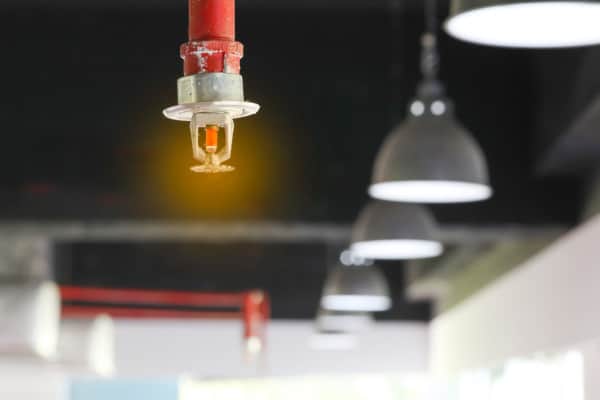
If you’re interested in diving into a little “light beach reading,” NFPA 13 is separated into 27 to 32 chapters (depending on the edition) that govern each part of the system. Below is a summary of some of the key chapters where there may be some interest for inquiring minds. Note that NFPA 13 underwent a significant revision in the 2019 edition, so we’ve included the appropriate chapters for 2016 vs. 2019 and later editions:
- Chapter 1 (2016 and later editions): The scope, purpose, and application describe the extent of the standard.
- Chapter 3 (2016 and later editions): Definitions that explain the terms used in the standard.
- Chapter 4 (2016 and later editions): General rules for all sprinkler systems. It also requires a document from the owner to the contractor and details the requirements for water quality. 2019 editions and later include more information in this chapter, including additional water supply rules.
- Chapter 6 (2016 edition)/Chapter 7 (2019 and later editions): Allowable materials. Most parts of a sprinkler system must be listed, which means they’ve undergone extensive testing for high pressures and durability. Sprinkler systems are NOT plumbing systems. They are subjected to much higher pressures and many components must be able to withstand higher temperatures, for example.
- Chapter 7 (2016 edition)/Chapter 8 (2019 and later editions) describes all of the system types—wet, dry, preaction, etc. Chances are, the system in your retrofitted building is water-filled, commonly referred to as a “wet-pipe system.” Regardless, this chapter covers all of the system varieties.
- Chapter 8 (2016 edition)/Chapters 9–16 (2019 and later editions): Sprinkler uses, spacing, positioning, obstruction rules, and more. While the 2016 editions and earlier used chapter 8 as a sort of “junk drawer” of sprinkler requirements, the 2019 and later editions break these rules out by sprinkler types (standard coverage, residential, etc.) in 7 separate chapters. The installation of piping is also broken out into a separate chapter (16) in the latest editions.
- Chapter 9 (2016 edition)/Chapter 17–18 (2019 and later editions): How to support the sprinkler system. The main chapters (9 and 17, in respective editions), for example, go over the rules for hangers and supports that hold pipes in place. Note that 2019 and later editions break out pipe and bracing for earthquake-prone areas (seismic design) in a new chapter 18
- Chapter 11 (2016 edition)/Chapter 19 (2019 and later editions) answers essential design questions governing how much water will flow.
- Chapter 23 (2016 edition)/Chapter 28 (2019 and later editions) has all the rules for what is required in the construction plans (commonly referred to as “shop drawings”) and how to hydraulically calculate the system’s water flow and pressure demands. The latter is a complex topic, so be prepared to nerd out.
- Chapter 27 (2016 edition)/ Chapter 32 (2019 and later editions): An introduction to the rules for maintaining the fire sprinkler system once it’s installed. This leads to an entirely new standard of mandatory rules: NFPA 25: Standard for the Inspection, Testing, and Maintenance of Water-Based Fire Protection Systems. This document is available in all of the places where NFPA 13 is found, including an online version at the NFPA website. But a building owner/manager should have an onsite copy of this document, too!
Again, different jurisdictions may reference different editions, as there is always a lag in the adoption of newer model codes and standards. And though most of the information remains the same across editions, the book was reorganized in 2019 to cover the topics in sequential order during a system installation. To learn more about these differences, check out our previous blogs:
- Significant Changes to the 2019 Edition of NFPA 13, Part 1
- Significant Changes to the 2019 Edition of NFPA 13, Part 2
I spy, with my little eye—stuff you can see on a fire sprinkler system after a retrofit
Much of the sprinkler system is buried behind walls or in control rooms (commonly called “riser rooms”). However, there are parts of the set-up, such as those in the stairwells, corridors, offices, or residences, that are seen every day. And facility managers can even visually inspect some of these components.
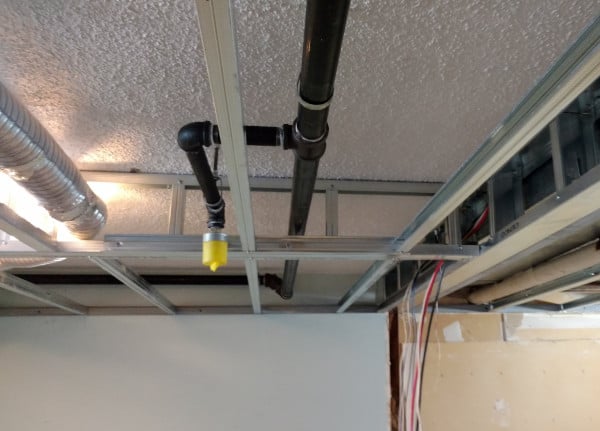
Stairways—fire sprinkler piping
Most stairways will have fire sprinkler and standpipe piping in them. Standpipes are often found in combination with sprinklers in buildings of a certain size that require them; they serve as a sort of internal network of fire hydrants that firefighters can access via hoses.
These pipes are usually vertical black steel or orange plastic (CPVC) lines, with some horizontal parts. Many times, the vertical piping is in a corner of the floor landing with a large outlet and handle—that is the “standpipe hose valve” that’s used by the fire department when they respond to a fire. Just like fire trucks connect to hydrants on the street, a standpipe hose valve on each floor is the firefighter’s hydrant.
Near the ceiling of each floor landing, it is common to see a section that has piping, a pressure gauge, a control valve, a drain, and a waterflow switch. This is called the “floor control assembly.” It serves as the shut-off to the fire sprinkler system on that floor. Every floor should have one.
The control valve can be supervised by a fire alarm panel—if someone shuts the valve, the fire department is notified. Some valves have a chain and lock, so they cannot be physically shut.
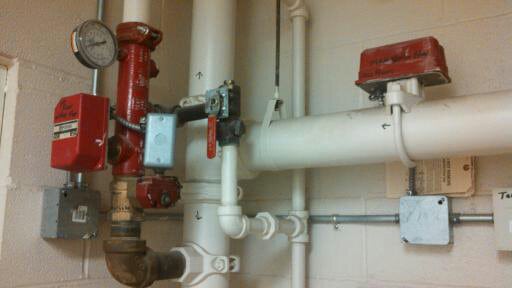
Corridors, public spaces, and dwelling units
The most identifiable parts and workhorses of the system are the individual fire sprinklers. Fire sprinkler heads are usually located in the ceiling (pendent) or on the wall (sidewall) near the ceiling. Some fire sprinklers are exposed—the frame, bulb, and deflector are visible. Others are visible only by spotting a flat, round plate. These are called “concealed sprinklers” and all of the operating parts are behind the “cover plate.”
Sprinklers come in many different colors and finishes, but it is important not to paint or caulk when remodeling or changing the colors in a dwelling unit. Additional layers of paint or caulk can delay or prevent sprinklers from operating during a fire.
Sprinklers are spaced apart from each other based on the rules in NFPA 13. For example, the amount of water pressure and the size of the sprinkler’s orifice can change the spacing of sprinklers. Generally, the higher the pressure, the fewer sprinklers installed.
Sprinklers in a corridor have a typical spacing of 12–20 feet apart. Inside a dwelling unit, at least one sprinkler is in each occupied room, such as kitchens, living rooms, and bedrooms. Small bathrooms and closets may not have a sprinkler, as model code does not require them in specific installations—though some state laws may.
Sprinklers inside a dwelling unit typically cover from 130–400 square feet per sprinkler and the larger room, the more sprinklers. The same goes for the other public spaces within the building. A library, salon, recreation, or exercise room will have similar spacing rules.
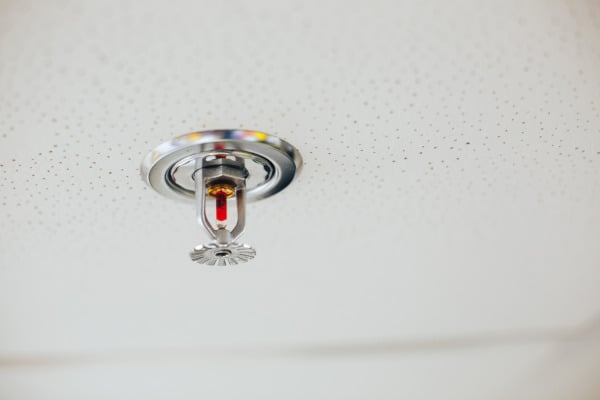
A little end-user knowledge goes a long way in a fire sprinkler retrofit
Qualified contractors and professional designers retrofit buildings with fire sprinkler systems. But each construction trade person and facility manager should take the time to educate end-users during the process, on each phase of installation. A basic level of knowledge helps owners, managers, and even residents maintain the system, know how it works, and have confidence that it will protect people and property during an emergency.
And regardless of the law governing retrofits for a specific building—or the age of the building and its use—fire sprinklers are a worthwhile investment. As the National Fire Sprinkler Association (NFSA) puts it, “Fire sprinklers buy time. Time buys life.”
If you need parts for a sprinkler retrofit or system maintenance, check out our selection of commercial sprinklers, residential sprinklers, system components, and installation tools.
Questions? Call us at +1 (888) 361-6662 or email support@qrfs.com.
This blog was originally posted at blog.qrfs.com. If this article helped you, check us out at Facebook.com/QuickResponseFireSupply or on Twitter @QuickResponseFS.


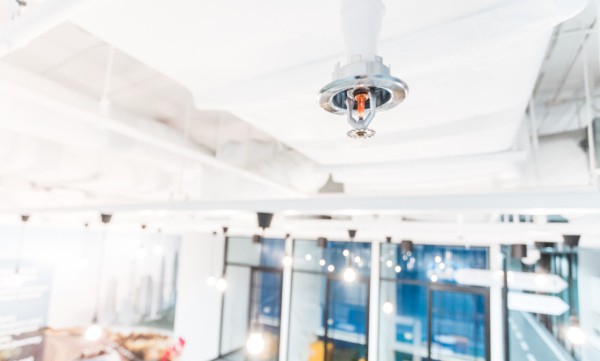
Our 4 storey strata has about 2000 Omega Sprinklers on a Wet System, serving the 4 residential floors (140 suites). These were recalled in about 2000, and Central actually supplied about 1500 replacements at that time. They were never installed, and 1100 Optima replacements are stored in a basement room (no idea what happened to the other 400). When our building was built (1993),the hydrant pressure was about 50 psi. It was doubled in about 2000. The excuse for not replacing the heads is that Central “volunteered”, so there is no requirement to replace them! I wonder, tho, if, with the doubled pressure in the system, that the heads may actually work, if/when needed. Note that the U/G parkade and the attic have Dry Systems. There are also sprinkler heads on all of the balconies (part of the wet system).
Of course, 1 % of fast acting heads are required to be tested after 25 years, and we are beyond that. Our Council says they will get them tested, but are certainly dragging their feet. I wonder if a qualified testing agency would be prepared to test Omegas.
I have been a resident since 2011, and only by chance discovered the stored heads. It took me some time to get (most of) the story.
I am concerned that: 1. were we to have a fire, the critical sprinkler might not activate, and the fire needlessly become much larger
2. our insurance might balk at covering us if they found that we have Omega heads
Doug — There’s a lot to unpack here, but a couple of points: the Omegas were recalled because the US Consumer Product Safety Commission (CPSC) “alleges that Omegas are defective and could likely fail in a fire,” and “on average, between 30 and 40 percent of Omegas removed from various locations across the country for testing failed to activate as they should.” We agree with you that this should be a significant cause for concern, which your “Council” (not sure if this means the building board or government) does not seem to share. While the water pressure doubled, too much water/pressure isn’t usually a critical problem when it comes to sprinkler performance, but it could be if the pressure challenges the pressure tolerances of the system — in any case, the system design objectives should be assessed by a fire protection professional. And failing to test or replace sprinklers at their appropriate time-based intervals is a code violation in any jurisdiction with codes referencing NFPA 25. Bottom line: it seems you may be right to be concerned and if what you describe is accurate, the responsible parties would likely be in violation of codes and potentially responsible for an unsafe situation. You might contact your authority having jurisdiction (AHJ) if the responsible parties will not address your concerns adequately.